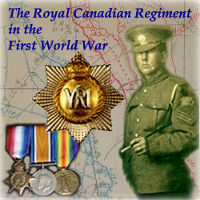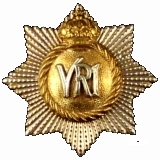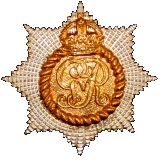
The First World War
An RCR Officer's Diary 1914-1918
MAY, JUNE 1917
MAY 1917
In 1st [May] the battalion moved to La Folie Area being quartered in Villers Huts and Villers au Bois.
Capts K.M. Holloway and C.L. Wood rejoined and Lieuts M.F. Gregg, R.W. Churchill, R.M. Millett, J.T. Probert, E.F. Davis and 94 other ranks joined as reinforcements.
A system of placing W.O's, N.C.O's and men on reduced rates of pay for a specified period on account of misconduct was introduced. This proved a very effective form of punishment and was also a means of compulsory saving as the amount so stopped was not taken away but merely held back until discharge.
The newly joined officers and the draft were immediately put on the "square" at the transport lines for training. A regular Regimental school has been established at the transport lines and all newly joined officers and men were kept there for a course of instruction. As a result not only was there great improvement in the smartness and general cleanliness of the battalion but the fighting efficiency was also raised. The idea had been copied from the Guards Brigade who months before were in the habit of carrying out ceremonial parades when resting in billets at Poperinghe.
It was at this time that the silver and gilt cap badge was taken into wear by the officers, the bronzed badge being restricted to the shrapnel helmet.
A system of placing W.O's, N.C.O's and men on reduced rates of pay for a specified period on account of misconduct was introduced. This proved a very effective form of punishment and was also a means of compulsory saving as the amount so stopped was not taken away but merely held back until discharge. The rates (from 2 to 6 months) were:
- Private, L/Corpl - 20 cents per diem
- Corpl - 25 cents per diem
- Sergt - 30 cents per diem
- C.Q.M.S., C.S.M. - 35 cents per diem
- W.O. I, Staff Sergt, R.Q.M.S., R.S.M. - 40 cents per diem
At some brigade sports at this time the battalion beat the 49th Cdn Bn at football and the officers beat them at baseball.
On 6th [May] Lt G.L.P. Grant-Suttie joined the battalion and Lieut H.J. Beard promoted Captain on transfer to C.A.P.C.
The battalion moved to Grange Tunnel on 7th [May] and supplied working parties on 8th [May]. Lts L.E. Longley, T.B. Rogers, C.C. Smith, E.B. Corsan, L.C. Linton and 8 other ranks joined. Lt E.T. Waugh joined he following day.
The battalion employed 20 men in making a rifle range in one of the old craters which had been in no man's land only a few days before. The whole scheme of training was a matter of improvisation in which great ingenuity was shown.
On 12th [May] the battalion crossed the famous Vimy Ridge and relieved 4th Cdn Mtd Rifles in the front line. Two cos. of P.P.C.L.I. Were attached to Bn this tour. Much work was carried out in securing the line of defence.
No man's land at this time was as much as 1400 yards wide and wire was placed 75 [yards] away. Much patrolling was consequently carried out and large patrols came into use, used in their truest form to an extent unobtainable where each front almost touched.
On 17th and 18th [May] the two cos. P.P.C.L.I. were relieved by a co. from 26th Cdn Bn and 25th Cdn Bn.
On 20th [May] the battalion was relieved by 116th Bn and returned to billets at Villers au Bois.
Much sickness occurred about this time, a type of low fever caused by the life in deep damp dugouts for months past.
On 23rd [May] Capt H.B. Poston rejoined and Lieut Ballantyne reported on appointment from P.P.C.L.I.
JUNE 1917
The first few days of the month were spent in practicing a raid. This was originally intended to be an attack at Avion, but it was afterwards changed to a raid.
A successful raid was often as effective as a small attack and far less expensive, it however incurred much detail and practice in order to obtain the maximum effect at the minimum loss.
On 6th [Jun] the battalion moved to the Quarries "Toronto Area" and relieved 5th Cdn Mtd Rifles.
News was received of the successful battle for Messines, an attack of even greater magnitude than the Somme or Vimy. It was of special interest to the Regiment as the battalion had on various occasions the front of the extent of the attack which commenced at Ploegstoet Wood and reached to "Hill 60." It was with great regret that the Regiment was unable to take part where every rise and fall of the ground was familiar.
Major C.R.E. Willets was awarded the D.S.O. On 7th [Jun].
The following day the raid on Avion was carried out. The whole Brigade attacked to the depth of about 800 yards, its task being to do as much damage as possible.
The battalion was allotted a front of about 150 yards. The railway which ran south-west from Avion through Bois-de-la-Chadiere being the centre line.
The plan of attack was on the "leap frog" principle, one wave having obtained its aobjective allowed the following wave to pass through it to a further one.
Although the frontage appeared to be narrow, yet there were many dugouts, etc., to be dealt with along the railway and owning to the depth of penetration there was a large exposed flank to be protected, so the battalion had a full task.
There were two objectives, the first, allotted to "C" Coy, the hostile trenches about 10 yards away, the second allotted to "D" Coy, a strong point at the meeting of the railway and the Avion road some 800 yards distant and the hostile trench running either side of it. The companies were divided into smaller parties of approximately 25 each, each detailed for a particular task. "C" and "D", the attacking Companied formed up in the jumping off trenches which had been prepared just in front of the front line. "A" Coy in reserve immediately took over the old front line when the raid started, "B" Company remained in reserve.
The artillery barrage opened at 11.45 p.m. and the raiders went over at 11.55 p.m. At 1.45 a.m. the signal for withdrawal, a gold and silver rocket, was sent up and a rear guard of riflemen and Lewis gunners remained to cover the withdrawal. This rearguard returned at 2.30 a.m. and by 5.00 a.m. everything was again normal. The night was propitious being very dark. "D Coy met with no resistance, the enemy being completely demoralized. "C" Coy, on the other hand, met with considerable resistance and some heavy hand to hand trench fighting took place.
Lieut Gregg distinguished himself. His party was held up by a machine gun which was causing casualties. He immediately organized his bombers and crawling round aproached the gun from a flank and personally put [it] out of action.
The mopping up party destroyed many dugouts with Stokes bombs, if fact the battalion cared out its task thoroughly, namely to kill as many of the enemy as possible, break his morale, and to do as much damage as possible. It is significant that no prisoners were taken, and when congratulating the C.O. over the telephone on the success of the raid the Brigadier said "I must congratulate you and your bloodthirsty ruffians."
One enemy Leis gun was brought back and one machine gun destroyed, time preventing its being brought back.
The whole front of the raid extended 1000 yards and penetration to 800 yards. It was estimated that 22nd and 156th Reserve Regiments which were opposed to us lost 250 killed in the trenches, 312 in destroyed duguts, 60 prisoners and 100 left wounded in the trenches, a total of 712 casualties. Seventy-eight dugouts were bombed.
Our casualties in the Brigade were 9 killed, 54 wounded, 2 missing, 3 died of wounds.
Lts E.F. Davis, R.W. Churchill, M.F. Gregg and E.T. Waugh were wounded. Lieut Davis died two days later.
The moral effect of the raid was very great. The Germans did not re-enter their trenches till the following morning when they appeared carrying back their wounded and burying their dead under the Red Cross flag.
On 9th [Jun] the battalion was relieved by part 42nd Bn (R.H.C.) and part of 49th Bn and returned to the "Vimy Line" where a draft of 40 other ranks joined them.
On 10th [Jun] Lt Col C.H. Hill, D.S.O., having taken over command of the Brigade, Maj Willets, D.S.O., assumed command of the battalion.
Lieut G. Hopkins joined from 7th Can Bn on appointment.
On 14th [Jun] the battalion relieved 52nd Cdn Bn at the Quarries and Grange Tunnel.
Lts Richards, Christie and Thompson joined on 19th [Jun] and later Lieut Barker and 75 other ranks.
Capt R.B. Day, Chaplain, left the Bn and Lt Corsan was detailed to the Entrenching Battalion.
Owing to the conditions of trench warfare the greatcoat which although essential for open war had been found too long and cumbersome becoming caked with mud and slime with the result that any men cut them short thus making them unserviceable and wasting cloth.
A system of tabs and buttons was therefore introduced by which the greatcoat could be looped up inside to 3/4 or short length as desired. This had the desired effect of giving a long coat when out of the trenches and a short one when in the trenches.
At a competition held at this time the battalion won both the Divisional and Corps prizes for the best transport.
On the 26th [Jun] the enemy evacuated the trenches raided by the Brigade on the 8th [Jun] and we immediately occupied, thus proving that a successful and thorough raid wil obtain the same object as a small attack at a vastly smaller expense.
At the end of the month Lt Col Dyer, 5th Cdn Bn, took over command of the 7th Cdn Bde. Brig Gen A.C. Macdonell, C.B., C.M.G., D.S.O., having been promoted to the command of 1st Cdn Division. Lt Col Hill accordingly resumed command of the battalion.
- The O'Leary Collection; Medals of The Royal Canadian Regiment.
- Researching Canadian Soldiers of the First World War
- Researching The Royal Canadian Regiment
- The RCR in the First World War
- Badges of The RCR
- The Senior Subaltern
- The Minute Book (blog)
- Rogue Papers
- Tactical Primers
- The Regimental Library
- Battle Honours
- Perpetuation of the CEF
- A Miscellany
- Quotes
- The Frontenac Times
- Site Map

![]() The RCR in the Great War
The RCR in the Great War
![]() War Diary
War Diary
![]() Battle Honours
Battle Honours
![]() Battle Bars and The RCR
Battle Bars and The RCR
![]() The RCR Battle Bar Ledger (pdf)
The RCR Battle Bar Ledger (pdf)
![]() Honours and Awards
Honours and Awards
![]() Roll of Honour
Roll of Honour
![]() Prisoners of War
Prisoners of War
![]() Cemetery List
Cemetery List
![]() Cemetery Map
Cemetery Map
![]() Courts Martial
Courts Martial
![]() Officers
Officers
![]() RSMs of The RCR (1914-1919)
RSMs of The RCR (1914-1919)
![]() NCOs and Soldiers
NCOs and Soldiers
![]() An Officer's Diary (1914-1918)
An Officer's Diary (1914-1918)
![]() Recollections of a Nonagenerian (R. England) (1916-1919)
Recollections of a Nonagenerian (R. England) (1916-1919)
![]() On to Bermuda (1914-15)
On to Bermuda (1914-15)
![]() England and France 1915-1916 (Hayes; 1931)
England and France 1915-1916 (Hayes; 1931)
![]() Overseas with The Royals (1915)
Overseas with The Royals (1915)
![]() Regimental History Pamphlet (1917)
Regimental History Pamphlet (1917)
![]() Amiens (1918)
Amiens (1918)
![]() Cambrai (1918)
Cambrai (1918)
![]() Monchy-le-Preux (1918)
Monchy-le-Preux (1918)
![]() Under-aged Soldiers in The RCR
Under-aged Soldiers in The RCR
![]() Not All Were Volunteers; The RCR and the Military Service Act
Not All Were Volunteers; The RCR and the Military Service Act
![]() Sentenced to Death by Court Martial
Sentenced to Death by Court Martial
![]() The 7th Trench Mortar Battery
The 7th Trench Mortar Battery
![]() A Regimental Goat
A Regimental Goat
![]() Regiment and Family, Bermuda 1914-15
Regiment and Family, Bermuda 1914-15
![]() "March the Guilty Bastard In"
"March the Guilty Bastard In"
![]() Surrendered as Stowaway
Surrendered as Stowaway
![]() Re-Visiting the Great War Roll of Honour for The RCR
Re-Visiting the Great War Roll of Honour for The RCR
![]() Canadian Corps Trench Standing Orders (1916)
Canadian Corps Trench Standing Orders (1916)

